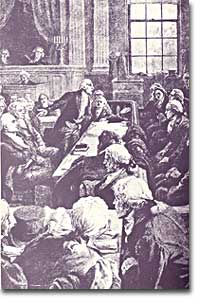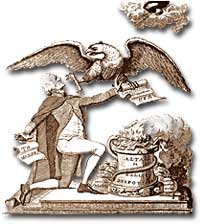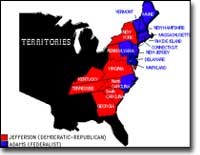20a. The Election of 1800

A captured moment in the amazing case of The United States v. Aaron Burr.
The election of 1800 between John Adams and Thomas Jefferson was an emotional and hard-fought campaign. Each side believed that victory by the other would ruin the nation.
Federalists attacked Jefferson as an un-Christian deist whose sympathy for the French Revolution would bring similar bloodshed and chaos to the United States. On the other side, the Democratic-Republicans denounced the strong centralization of federal power under Adams's presidency. Republicans' specifically objected to the expansion of the U.S. army and navy, the attack on individual rights in the Alien and Sedition Acts, and new taxes and deficit spending used to support broadened federal action.
Overall, the Federalists wanted strong federal authority to restrain the excesses of popular majorities, while the Democratic-Republicans wanted to reduce national authority so that the people could rule more directly through state governments.
The election's outcome brought a dramatic victory for Democratic-Republicans who swept both houses of Congress, including a decisive 65 to 39 majority in the House of Representatives. The presidential decision in the electoral college was somewhat closer, but the most intriguing aspect of the presidential vote stemmed from an outdated Constitutional provision whereby the Republican candidates for president and vice president actually ended up tied with one another.
Votes for President and Vice President were not listed on separate ballots. Although Adams ran as Jefferson's main opponent, running mates Jefferson and Aaron Burr received the same number of electoral votes. The election was decided in the House of Representatives where each state wielded a single vote.

During the election of 1800, Federalists cast Thomas Jefferson as an infidel because of his strict advocacy for the separation of Church and State.
Interestingly, the old Federalist Congress would make the decision, since the newly elected Republicans had not yet taken office. Most Federalists preferred Burr, and, once again, Alexander Hamilton shaped an unpredictable outcome. After numerous blocked ballots, Hamilton helped to secure the presidency for Jefferson, the man he felt was the lesser of two evils. Ten state delegations voted for Jefferson, 4 supported Burr, and 2 made no choice.
One might be tempted to see the opposing sides in 1800 as a repeat of the Federalist and Anti-Federalist divisions during the ratification debates of 1788-1789. The core groups supporting each side paralleled the earlier division. Merchants and manufacturers were still leading Federalists, while states' rights advocates filled the Republican ranks just as they had the earlier Anti-Federalists.

Support for Thomas Jefferson throughout the entire Western frontier assured his victory over John Adams in the presidential election 1800.
But a great deal had changed in the intervening decade. The Democratic-Republicans had significantly broadened the old Anti-Federalist coalition. Most importantly, urban workers and artisans who had supported the Constitution during ratification and who had mostly supported Adams in 1796 now joined the Jeffersonians. Also, key leaders like James Madison had changed his political stance by 1800. Previously the main figure shaping the Constitution, Madison now emerged as the ablest party organizer among the Republicans. At base the Democratic-Republicans believed that government needed to be broadly accountable to the people. Their coalition and ideals would dominate American politics well into the nineteenth century.
As the first peaceful transition of political power between opposing parties in U.S. history, however, the election of 1800 had far-reaching significance. Jefferson appreciated the momentous change and his inaugural address called for reconciliation by declaring that, "We are all Republicans, we are all Federalists."






